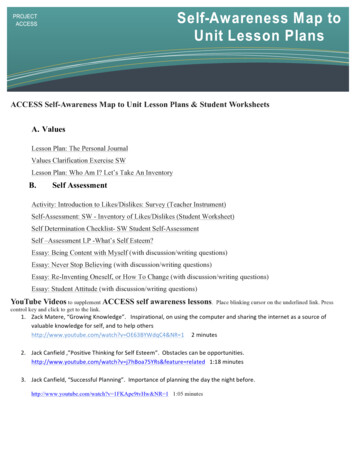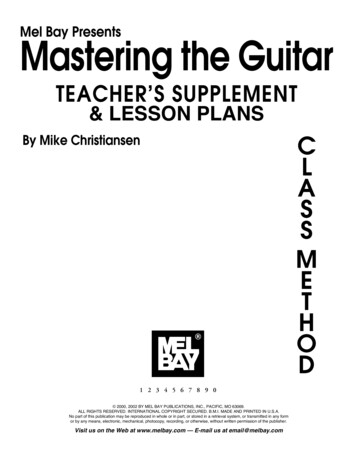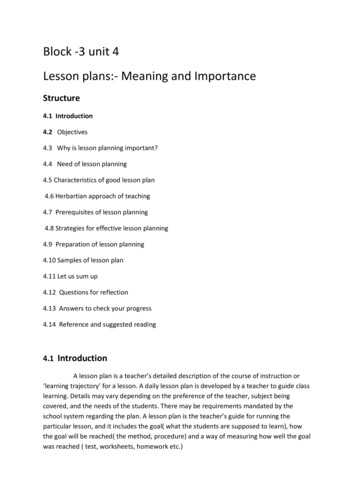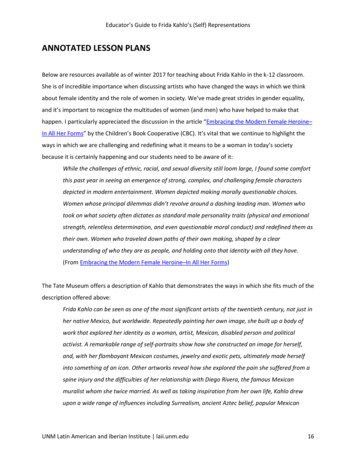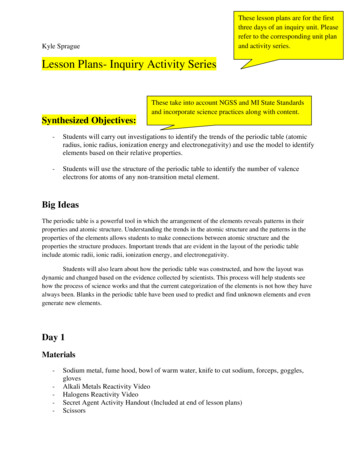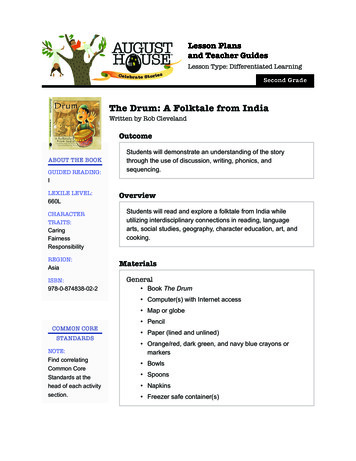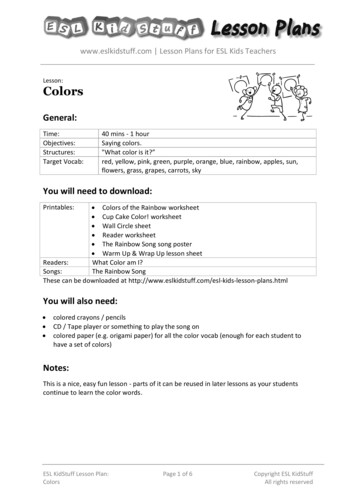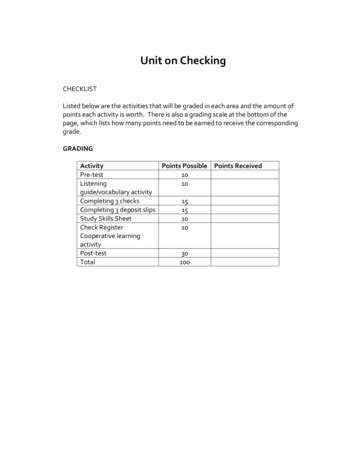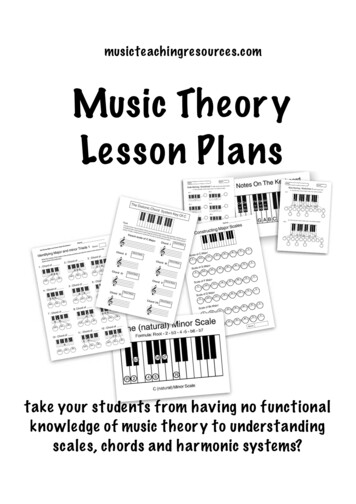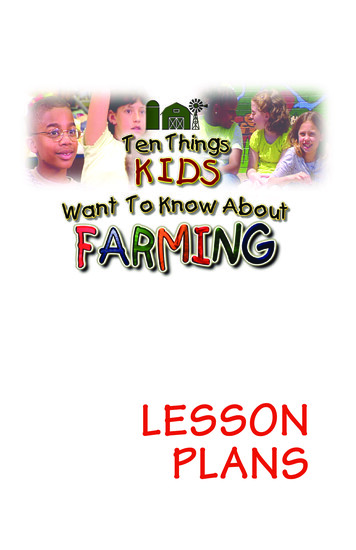
Transcription
LESSONPLANS
LESSON PLANSVideo Overview:“Ten Things Kids Want to Know AboutFarming” is a 22-minute educational video.It takes students on a series of field tripsto farm and ranch locations throughoutthe United States, offering a firsthand viewof what happens to produce the food andclothing we use every day.Agriculture is a vital part of American life,even if most of us have not spent much timeon a farm. “Ten Things Kids Want to KnowAbout Farming” answers such basic questionsabout food production such as: what cangrow on an acre, what is soil, and how muchwater is needed to grow a crop?Scenes of farmers using tractors andirrigation systems, harvesting crops andtrees, milking cows and herding sheep invitestudents to experience a world largelyunknown to them. By answering questionsthat kids commonly ask about agriculture,farmers and ranchers share the realities ofmaking a living off the land.Lesson Plan Overview:The “Ten Things Kids Want to Know AboutFarming” lesson plans help teachers expandupon ideas presented in the video. Throughclassroom and field activities, the 10 lessonplans offer creative ways of teachingfundamental concepts in math, science,history, social science, geography, languagearts and visual arts. Each lesson planfeatures a specific learning objective, ways ofconnecting the lesson to the core curriculum,vocabulary, a list of materials and proceduresfor conducting the lesson, additional ideas forexpanded learning and suggested web sitesfor background information.1
Video and Lesson Plan Orders:The “Ten Things Kids Want to Know About Farming” videowas co-produced by the American Farm Bureau Federationand the AFB Foundation for Agriculture. Single copies ofthe VHS tape or DVD version are available for 17.00 each;2 to 99 copies are 14.00 each. Orders of 100 or more are 12.00 each.The “Ten Things Kids Want to Know About Farming” lessonplans were developed by David O. Pippin, president ofDavid Pippan, Inc. in Richmond, Virginia, in consultationwith teachers and staff of the American Farm BureauFoundation for Agriculture and the Virginia Foundation forAgriculture in the Classroom. Single copies are 5.00 each;2 to 99 copies are 3.00 each; 100 or more are 1.50 each.Orders may be placed by phone at 202-406-3701, by fax at202-314-5121 or on-line at www.agfoundation.org.About the Foundation for Agriculture:The American Farm Bureau Foundation for Agriculture is a 501 (c)(3) not-for-profit affiliate of the AmericanFarm Bureau Federation . This teacher’s guide has beendeveloped to fulfill the Foundation’s mission of buildingagricultural awareness and understanding througheducation.For information about how to order this and othereducational resources, visit www.agfoundation.orgor contact:American Farm BureauFoundation for Agriculture 600 Maryland Avenue, SWSuite 1000WWashington, DC 20024Phone: 800-443-8456Fax: 202-314-5121Web Site: www.agfoundation.org2
A List of Lessons andLearning ObjectivesLesson 1:Design a FarmLesson 2:Discover an AcreLesson 3:Nature’s FibersLesson 4:Corn — It’s Not All Ears!Lesson 5:How Much Water?Lesson 6:Is Your Soil Like My Soil?Lesson 7:Fewer Farmers Greater ProductionLesson 8:If I Were a Farm KidLesson 9:How Many Cows? Students will understand the many facets of a farm throughtheir research, design process and by becoming “farmers.” Students will visualize and understand the actual size of asquare foot and ultimately an acre. Students will understand that cotton is a valuable agriculturalcrop and will gain an understanding of how the fibers aremade into many products they use, including cloth. Students will discover the many uses of corn and corn byproducts. Students will gain an understanding of the irrigation processand the importance of conservation. Students will understand that soil has many components andthat all soils are not alike. Students will understand the importance of machinery ontoday’s farms and changes brought by the U.S. industrialrevolution. Students will gain an understanding of life on a farm byputting themselves in the role of a farm kid. Students will determine how many cows are needed toprovide their class, grade level, school and their family withmilk.Lesson 10: Nature’s Renewable Resources Students will understand the basic functions of trees andrecognize the many products that come from trees.3
4
LESSON 1: Design a FarmObjective: Students will understand the manyfacets of a farm through their research,design process and by becoming “farmers.”Curriculum Connection:Art (creativity, design)Language Arts (writing, listening, speaking)Study Skills (research)Computer SkillsSocial Science (map skills)History (families and communities)U. S. GeographyCooperationBook List:Harvest Year, Cris Peterson, Boyds Mills PressFarming, Gail Gibbons, Holiday House Ranching (Let’s Investigate), Scott Wrobel, Creative EducationVocabulary: Farm – a tract of land devoted to agricultural purposes Ranch – a large farm for raising horses, beef cattle or sheepMaterials: Library books, magazines and catalogs with farm andagriculture themesComputers with Internet accessDifferent types of maps with keysBlank U. S. map for each studentCrayons, colored pencils and/or markersDrawing paperPoster board (one/group)Small sticky notepadsPROCEDURES:Farms in the United States R eview and discuss the types of farms shown in the video with the class.In what states were the farms located? What types of farms were locatedin each of the states shown? Why are certain types of farms (e.g. cottonfarms) located in some states but not in others? Explain the varyingclimates in different parts of the United States. Some regions have longergrowing seasons than others, allowing them to grow crops requiring alonger growing season. What types of farms are located in your state?Why? G ive each student a blank U. S. map. Ask them to locate, color and labelthe states with farms shown in the video. Write the type of farm that waslocated in each state. L ocate, color and label your state. Write the name of at least one type offarm located in your state. Can you name more than one?5
LESSON 1: Design a Farm continued . . .Creating a Farm Map A fter watching the video, ask the students to write a list of things that canbe seen on a farm. D ivide the class into several farms (4 – 5 students per group). Ask studentsto compare their farm lists and make a master list of the group’s items.Which items do their lists have in common? Which items differ? E ncourage each group to be a different type of farm (e.g. a dairy farm, ahog and corn farm, a cotton farm, etc.). Allow the students to decide. A fter groups decide their type of farm, have each group review its farmitem list. Are there items that should be removed for their particular typeof farm? Should anything be added? O nce each group’s master list has been established, have them begindesigning their farm by having each student draw pictures of items fromthe master list. S tudents may also look for pictures of the items they plan to have ontheir farm in magazines, seed catalogs and equipment catalogs or on theInternet. These pictures may include crops, animals, equipment, buildings,etc. As a group, review the pictures to start planning the layout of the farm. Give each group a piece of poster board and one sticky notepad. W rite items from the master list on the sticky notes. Using the picturesas a reference, start placing the sticky notes on the poster board. Whichitems require more space? Which items require less space? Arrange andrearrange accordingly. O nce the group agrees upon final placement of all items, it’s time to startdrawing the farm map. Some items such as fences can be drawn on theposter board. Other items can be drawn on separate sheets of paperand glued to the poster board. By drawing on separate sheets of paper,everyone can participate at the same time and not have to crowd aroundthe poster board. Create a key/legend for the map of their farm. Label all parts. Encourage students to be creative with their maps.ADDITIONAL IDEAS: H ave students make scale models of their farms or models of importantbuildings on their farm. C ontact your County Farm Bureau or Extension Service and invite a localfarmer to visit your class. Ask the farmer to share information about his orher farm while students are designing their farms. If farmers from differenttypes of farms are available, invite them to participate in a panel discussionfor the class. Ask students to prepare questions for the farmers and mail acopy of the questions to farmers before the visit, to help them prepare forthe class discussion.6
LESSON 1: Design a Farm continued . . . C ontact your state Agriculture in the Classroom representative aboutprograms available for your school. For a state contacts list visitwww.agclassroom.org. H ave students write letters to a farmer asking him or her about life on afarm. Share the information with the class. Some of the web sites listedbelow have addresses of farmers who are willing to be pen pals.Web Site Information for Teachers:4-H Virtual Farm /main.htmlThis site introduces you to some of the people who earn their living off theland. You’ll see the different types of farms where they live and work. You’lllearn how foods get from the farm to your plate.Family Farms Around the Worldhttp://www.disknet.com/indiana biolab/farms.htmThe 150 farm homepages offer a feel for life on a farm in 40 states and 18countries. Most include information about animals, crops, wildlife, marketing,soil, climate and other information. Farmers will answer e-mail letters.Farm Life Live by Ag Dayhttp://www.agday.org/tc/tc-farmlife.htmlFarm families and their children share real life experiences about farm andranch life in the United States. Families will answer e-mail questions.What is a Farm? by American Farm Bureau Foundation for Agriculturehttp://www.ageducate.org/news/what farm.htmlIdentifies eight farm types based on USDA survey information.7
LESSON 2: Discover an AcreObjective: Students will visualize andunderstand the actual size of a square footand ultimately an acre.Curriculum Connection: Math (using calculators, problem solving, units of measure, areaand perimeter, multiplying, estimating)Science (plants)HistoryCooperationVocabulary: Acre – a piece of land measuring 43,560 square feet Square foot – one foot x one foot S quare foot gardening – a method that sets plants in a gridpattern rather than in rows, in order to save space.Materials:Yard stickMeasuring tapesCalculatorsPencils and paper12” x 12” construction paper or cardboard (three per student)Seeds or seedlings (see list under “Plant a Square Foot Garden”)Square foot pots and potting soil if container gardeningPopsicle sticks to label seeds after they’ve been plantedHeavy string or yarnStaple gun or tacks8’ landscape timbers (5)Handsaw or chain sawShovel or rototillerPROCEDURES:Understanding Square Feet G ive each student a 12” x 12” piece of construction paper or cardboard.Explain this is a square foot. It measures 1 foot x 1 foot. The area of thepaper is one square foot. T o measure the perimeter, have the students use their ruler to measure allfour sides. The perimeter is four feet. C lear a space in the classroom or go to a room such as the cafeteria orgymnasium where students will be able to lay all of their squares on thefloor and view them. Pretending that they are laying out a square foot garden, ask the studentsto place their squares on the floor one at a time. Each square that is placedon the floor must touch at least one side of another square. Each squarewill represent a crop or plant in the garden. Keep in mind that differentplants require different amounts of space in which to grow. For example,8
LESSON 2: Discover an Acre continued . . .one tomato plant or 16 radish seeds could grow in a square foot. Once the“garden” has been laid out, ask the students to count the number of squarefeet in their garden. Repeat this exercise several times, allowing students toarrange their squares in different patterns. Each time, ask them how manysquare feet are in their garden. Students will understand that no matter howthe squares are arranged, the garden has the same number of square feet. E ach time the garden is laid out, have students measure the perimeter.Does it change?Field Trip T his is an opportunity to take students outside to measure the areaand perimeter of different spaces. Some possible things that could bemeasured are squares in the sidewalk, the top of a picnic table, areasmarked with chalk on the sidewalk or blacktop, doors, windows, etc. Becreative. B efore going outside, review the activity “Understanding Square Feet.”Divide the class into groups with 3 students in each group. Two studentswill measure the area (length x width) and perimeter (add the lengthof all sides) of the designated spaces, while one student records themeasurements. After the measurements have been taken, have studentscalculate the number of square feet in the space as well as the perimeter ofthe space. O nce students have mastered “Understanding Square Feet,” it’s timefor them to visualize an acre. Take the students to a large open space,preferably the football/athletic field; this is the perfect site for this exercise,because an acre is approximately the size of a football field. If your schooldoes not have a football/athletic field, look for other open spaces such asa playground for students to measure. Also, explain that an acre is 43,560square feet, approximately the same size as a football field, which is 300feet x 150 feet.Plant a Square Foot Garden T his activity provides a great opportunity to involve parent volunteers oryour parent-teacher organization. C hoose a school location for the garden that receives at least six hours ofsunlight each day. It should also be a well-drained area. Till or turn the soil wi
LESSON PLANS Video Overview: “Ten Things Kids Want to Know About Farming” is a 22-minute educational video. It takes students on a series of field trips to farm and ranch locations throughout the United States, offering a firsthand view of what happens to produce the food and clothing we use every day. Agriculture is a vital part of American life, even if most of us have not spent much .


